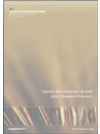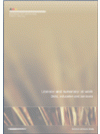This report looks at the use of literacy and numeracy skills at work, and how this relates to the skills and education of employees. It uses data from the Adult Literacy and Lifeskills (ALL) survey to look at how well employees’ skills match the literacy and numeracy practices that they undertake at work. It looks at how skills and education relate to different sets of practices, such as financial literacy and numeracy. It also identifies which groups of employees are more likely to have a skills shortfall or skills excess, and some of the barriers to further training for those with a skills shortfall.
Purpose
This report addresses the following questions:- What are the different types of literacy and numeracy practices at work?
- How do these literacy and numeracy job practices relate to measures of job type and skill?
- What is the relationship between the skills, qualifications and experience of employees and the literacy and numeracy practices in their jobs?
- What is the extent of match and mismatch between the literacy skills of employees and their literacy and numeracy practices at work?
- What access do people with low skills and frequent literacy and numeracy job practices have to further education and training?


